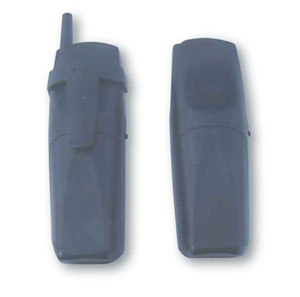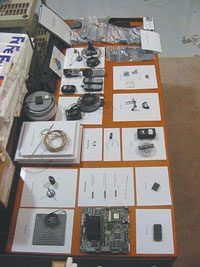Plastic Antennas Mold Flexible New Frontier
 |
| Integral Technologies’ Plastenna product is an electrically conductive polymer. This application can turn the entire outer case of a handheld wireless device, such as a cellular telephone, into an antenna. |
An electrically conductive resin technology may soon free warfighter and civilian wireless devices from bulky aerials. The proprietary recipe can be added to any of the thousands of polymers used to manufacture cases and components, turning the entire bezel of a cellular telephone or handheld radio into an antenna.
Antenna technology is a vital but often unappreciated component of mobile communications systems. Advanced radio systems, such as the handheld equipment for the U.S. Defense Department’s Joint Tactical Radio System and the Mobile User Objective System feature a variety of advanced algorithms and signal processing technologies packaged in small containers. But these devices and the next generation of commercial wireless products cannot rely on traditional antenna technologies because of size and performance issues. New approaches are being developed to provide both soldier and consumer with rugged, lightweight antenna systems capable of performance comparable to metal-based antennas.
One firm involved in advanced aerial systems research and development is Integral Technologies Incorporated, Bellingham, Washington. The company has a patent for its composite polymer technology called Electriplast, which can be used in moldable antennas. It also has a second patent for the Plastenna technology, which uses conductive resins in a variety of antenna forms.
According to Thomas Aisenbrey, Integral’s general manager, chief technology officer and inventor of Electriplast, the recipe can be applied to a variety of polymer resins, making them capable of running direct current. It is the ability to channel electrical current directly that makes Electriplast unique. Although other electrically conductive polymers exist, they function like semiconductors and will burn or melt if current is run through them, he says.
Aisenbrey claims that his recipe will work with any of the 13,000 resins now in use. This flexibility allows the manufacturers of components such as wireless handsets to work with familiar materials. Adding Electriplast into these industrial plastics makes them electrically conductive, but it does not change their production or structural characteristics, he explains.
For radio frequency (RF) functions, Plastenna technology transforms a cellular telephone or radio case into an antenna. This application may replace the internal metal antennas used in many handheld wireless devices, which Aisenbrey notes are not very efficient. “If you expose these antennas to human touch, they totally detune themselves. Anything with a dielectric greater than 1—which is anything but air—is going to severely affect the antenna. A lot of those internal antennas also have plastic covers over them, which gives them a lot of loss, too,” he says.
He is adamant that Plastennas are up to 80 times more efficient than internal antennas. The matrix that makes Electriplast conductive will not ground current like a solid substrate. A polymer antenna in a handheld device also is not as sensitive to the close proximity of components such as circuit boards and the effects of human touch. “It’s a lot different than a solid substrate like a piece of copper or brass,” Aisenbrey says.
In antenna applications, Aisenbrey maintains that Electriplast’s performance is competitive with that of copper. The polymer also may have some advantages in signal reception. “What happens when you get gain in an antenna is that it starts out as an isotropic ball. When you increase gain, you push that ball down—that’s what gives you gain—so that it almost looks like a pancake. With this material, we’re still in the same kind of gains as the squashed pancake, but we’re maintaining a good portion of that ball,” he says.
 |
| Known as Electriplast, Integral Technologies’ conductive polymer technology can be used in a variety of applications such as antennas, shielding, lighting circuitry, switch actuators, resistors, medical devices, heat sinks and cable connectors. |
Aisenbrey adds that a number of factors can affect signal propagation. Most signals are transmitted vertically or horizontally from a tower. Radio waves perform like light waves because they can be reflected and refracted by a variety of objects. “What happens when that signal is vertically polarized by the time it gets to your cell phone? It could have bounced off of buildings, cars or the ionosphere. It pretty much becomes a tangled mess of cross polarization,” he says.
If the antenna on a wireless device is vertically polarized, its best performance will be at 90 degrees. However, getting optimal performance from such an antenna is difficult because not many signals are that accurate. But the matrix structure of Electriplast is homogenized in the resin, allowing it to be more receptive in three dimensions. “It doesn’t care what axis it’s on from a standpoint of cross polarization,” he says.
The Electriplast polymer also is useful in a variety of other applications such as in thermal conducting. Because it is injection molded instead of machined, heat-resistant electrically conductive components such as heat sinks and heat pipes can be directly molded into casings and other systems. The material’s ability to absorb radiation also is important for shielding parts from RF interference. Shielding is often made of metal, which can reflect and refract signals. But Electriplast absorbs signals without any of the problems associated with metals, he says.
Aisenbrey also has made electrical wiring from extruded plastic in his laboratory. This electrically conductive polymer wiring is lightweight—roughly 40 percent lighter than aluminum—making it potentially useful to the aerospace industry. “Imagine a large aircraft—let’s use a 747 as an example. You might have in excess of 5,000 pounds of copper wiring in such an aircraft. What would happen if you cut that weight in half? How much energy savings would you have in something like that alone?” he says.
The material has potential applications in covert intelligence gathering. Aisenbrey notes that antennas can be molded to look like automobile roof racks and door panels. This feature also has battlefield applications. For example, many command vehicles have multiple antennas, making them obvious and tempting targets. Vehicle and crew survivability may be greatly enhanced if these aerials were disguised as body panels. “There are lots of things that can be done now that could never be done with solid metals,” he says.
Efficient polymer-based antennas would be well received by the military community, observes Bradley J. Curran, an industry analyst with Frost and Sullivan in San Antonio, Texas. He notes that in urban combat situations such as in Iraq, it becomes very difficult to communicate once soldiers are inside buildings. Often, troops must put a radio in a doorway or point an antenna out of a window to remain connected. “Anything that will help warfighters on the ground to talk while they’re mobile on foot or in a vehicle is really helpful,” he says.
Curran notes that efficient manportable systems are important to soldiers in tactical units. Communications equipment often is built for higher echelons and is either high-bandwidth or satellite-based. First responders such as law enforcement organizations and fire departments also would benefit from these lightweight technologies. “So anything in the VHF [very high frequency] realm, especially while mobile, would find wide acceptance,” he offers.
Electriplast originated from a contract to produce small rugged satellite antennas for the trucking industry. These aerials were to be mounted on the back of a tractor-trailer’s cab to receive data from a constellation of low-earth-orbiting satellites managed by a company called Orbcomm that hired Integral Technologies to produce the antennas. Integral then approached Aisenbrey to work on the project, which he viewed as a challenge because he believes that antenna technology has not significantly progressed in 50 years. “Most everything you see is still just a piece of wire sticking up in the air,” he says.
But as the program was ready to launch, Orbcomm went bankrupt. During the Chapter 11 process, there was a brief period when it appeared that the project would be reinstated. Aisenbrey agreed to stay with Integral and began to improve the satellite antennas. It was during this time that he began working with conductive plastics.
Discovering that existing polymers were not conductive enough for antennas, Aisenbrey began to experiment with different mixtures. When tests resulted in a material as conductive as copper, he searched for patents, but found none in this area. Integral then tested and verified the recipe’s effectiveness through a third party. Aisenbrey notes that through experimentation with various polymer mixes, he now has two approved patents and more than 70 pending.
Although the Orbcomm project was unsuccessful, Integral is now working with several Fortune 100 companies to develop prototypes using Electriplast technology. Aisenbrey expects to have several products in consumer markets in early 2005. The company also is working with the U.S. Defense Department on military applications.
Web Resources
Integral Technologies Incorporated: www.itkg.net
Frost and Sullivan: www.frost.com




Comments